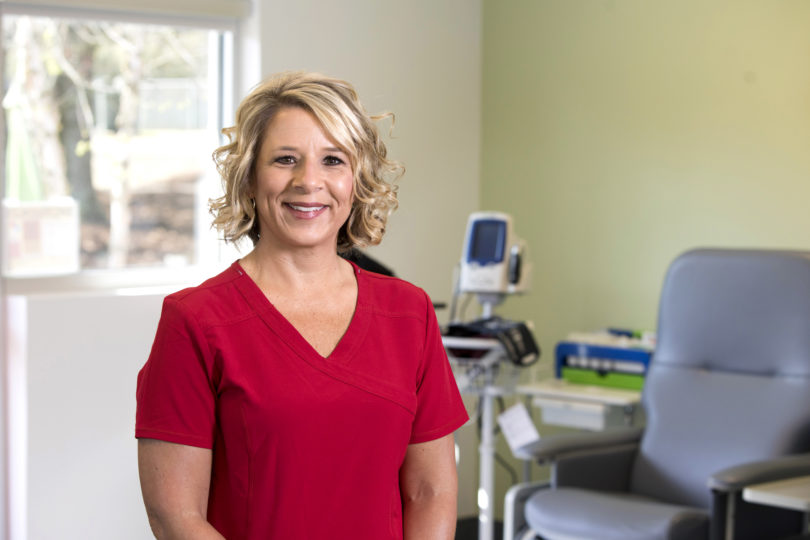The patient doesn’t flinch as occupational health nurse Jenney Roundtree inserts a needle in her arm, seeking a vein. Roundtree is drawing blood to test if the research technician—who works in a UGA infectious disease lab—is resistant to hepatitis B. If not, she’ll need a booster shot.
Twice a week, Roundtree offers clinical services for the university’s Research-Occupational Health and Safety Program, sharing space with UGA’s Clinical and Translational Research Unit on the Health Sciences Campus. Researchers can be checked for exposure to diseases, get required vaccinations and be fit-tested for a respirator at the clinic.
Previously these services were handled by a local medical provider, and it took an average of 72 days for personnel who needed occupational medicine services to get approved for work in biosafety or animal research. Bringing these services back in house and eliminating extra paperwork offers enormous time savings, according to Chris King, associate vice president for research and director of the Office of Research Integrity and Safety.
“This new development is going to be great for our researchers,” King said. “It’s vital that people are protected and safe when they are doing their work for UGA, but people aren’t able to do their jobs if they’re waiting on clearance.”
King has firsthand experience. This month, he was due to have blood drawn for a rabies titer and a semi-annual tuberculosis test. Using UGA’s new Professional Education Portal (pep.uga.edu), he made an appointment at the new clinic and was able to get it done in 24 hours.
UGA’s Research-Occupational Health and Safety Program oversees workplace safety for personnel involved in research using animals or biohazardous agents. The program applies to faculty, staff, students, volunteers and visitors who work with humans, animals or animal tissues, fluids, secretions and excretions; who work with biohazardous agents; and who handle caging and related equipment contaminated by animal tissues, fluids, secretions and excretions or who routinely enter into facilities where animals are maintained.
About 3,500 people are enrolled in the program, and provision of medical services has more than doubled in the last five years, with nearly 500 medical services provided annually.
Since the R-OHSP clinic opened March 19, Roundtree has seen about 30 patients, checking their immunity from prior vaccines, administering new vaccinations and providing other tests. Soon she’ll offer fit-testing for respirators—checking whether the equipment properly fits the face of the wearer—and researchers can have their lung function tested and get fitted for a respirator in one appointment, rather than the two that were required previously.
With today’s patient, Roundtree discusses the option of a tetanus shot and then administers a skin test that checks for TB exposure. The patient will need to have the skin test checked within 48-72 hours to determine if further action is needed, but the tetanus shot is optional.
“A tetanus shot is not required based on the kind of work done in your lab,” Roundtree tells the patient. “But it’s available if you want it. We just want you to be safe.”
For more on UGA’s Research-Occupational Health and Safety Program, visit research.uga.edu/ohsp.







